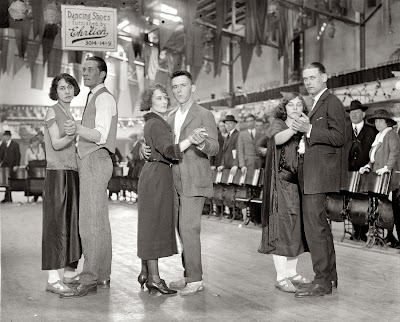
King Oliver's Creole Jazz Band, Chimes Blues.
King Oliver's Creole Jazz Band, Snake Rag.
Jelly Roll Morton, New Orleans Joys.
Jelly Roll Morton, Wolverine Blues.
Clarence Williams' Blue Five, Kansas City Man Blues.
Mamie Smith and the Harlem Trio, Lady Luck Blues.
James P. Johnson, Scouting Around.
Fletcher Henderson Orchestra, The Dicty Blues.
Bessie Smith, Jail House Blues.
Bessie Smith, Cemetery Blues.
Bennie Moten's Kansas City Orchestra, Elephant's Wobble.
Ada Brown with Bennie Moten's Kansas City Orchestra, Ill Natured Blues.
King Oliver's Creole Jazz Band, Working Man Blues.
When Caesar did the Chicago
He was a graceful child,
Those sacred chickens
Just raised the dickens
The Vestal Virgins went wild.
Whenever the Nervii got nervy
He gave them an awful razz
They shook in their shoes
with the Consular Blues
The Imperial Roman jazz.
F. Scott Fitzgerald, "Porcelain and Pink" (collected in Tales of the Jazz Age, 1923).
The harvest of a dozen days in 1923, year of wonders:
April 5, Richmond, Indiana:

"Chimes Blues," one of the tracks recorded by Joe "King" Oliver's Creole Jazz Band in their initial session, has the band's new trumpeter's debut solo on disc. The track serves as a historical processional: it opens with classic New Orleans polyphony, thins to a string of spotlit players (Johnny Dodds' clarinet, Lil Hardin's piano chimes) and then Louis Armstrong, with his two-chorus self-introduction, brings the future with him.
With Baby Dodds (d), Honore Dutrey on trombone and Bill Johnson on banjo. Released as Gennett 5135 c/w "Froggie Moore"; on Portrait of the Artist as a Young Man.
June 22, Chicago:
Oliver's band both embodied New Orleans (its records are the summation of three decades of New Orleans jazz playing) and looked beyond it. After all, Oliver's group in 1923 was a Chicago dance band. As Allen Lowe wrote, Oliver's band were not traditionalists so much as a pack of dedicated modernists, looking to make commercial records by raiding choice pieces from the past and arranging them in new shapes.
Tracks like "Snake Rag" and "Jazzin' Babies Blues," the former recorded on this date, document the collective Oliver sound at its peak, in which a four-horn ensemble seemed like one hydra-headed player. "Snake Rag" is tight and relentless: listen to the chutes-and-ladders hornplay of Oliver and Armstrong, followed by Dutrey's retorts on trombone.
Released as OKeh 4933 (an earlier version was cut in April for Gennett) c/w "High Society Rag"; on Archive of American Pop.
July 17, Richmond, Ind.:
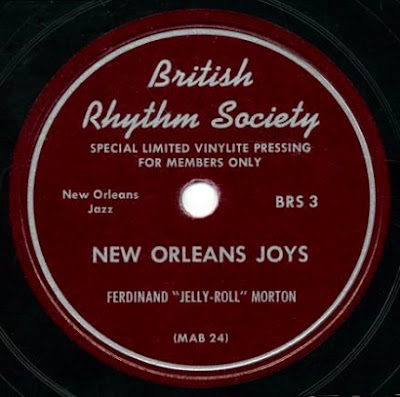
Ferdinand "Jelly Roll" Morton was born in 1890 but he always claimed he'd arrived a few years before. His rejiggered birthyear (1885, sometimes) was convenient because he then could argue that he had invented jazz by himself, sometime around 1902, when he was actually only about 12.
Whatever age he was, Morton left New Orleans in 1907 and would never come back. He became a pimp, a pool shark, a roving gambler, a whorehouse pianist, a brutal cutting contest pro, a night club impresario, a comedian. He was in Tulsa, Chicago, Los Angeles, Gulfport, Mississippi. He met James P. Johnson in New York, W.C. Handy in Memphis. He asked Handy's group to play a blues, to which Handy replied that "the blues couldn't be played by a band." A proposition Morton would dedicate himself to disproving. Bunk Johnson recalled seeing Morton in Columbus, at the Great Southern Hotel, "playing waltzes and rags for the white people."
And somewhere on the road during these years Morton wrote some of the 20th Century's greatest works for solo piano: "New Orleans Blues (or Joys)," "The Pearls," "King Porter Stomp," "Jelly Roll Blues," "Wolverines."
Morton said he'd always been a jazz player. There was a precise difference: ragtime was a dialect, jazz was a language. No, better still, ragtime was a sect, jazz a religion. Ragtime had its standards and restrictions; jazz had to have nuance and variety, contrast--melodically, rhythmically--and the ability to move, to think with your hands. (Of course, Morton was greatly indebted to ragtime, having sent Scott Joplin compositions for review (possibly "King Porter Stomp"), and works like "Grandpa's Spells" are basically tricked-up rags.)
In 1923, he returned to Chicago and began making records. Among the first were six solo piano tracks, including, on this date, "New Orleans Joys." "Joys" isn't dramatic: there are no pounded chords, no vaults across the keyboard. In true American style, it's built upon ratifying the separation of powers--Morton's right hand plays independent of his left (sometimes in different tempos), so he keeps the beat while simultaneously improvising and developing melodies. Morton becomes a self-contained jazz band of one: playing melodies, advancing harmonies, providing the rhythm.
"New Orleans Joys" was released as Gennett 5486; on 1923/1924.
July 18, Richmond, Ind.:

The next day, Morton recorded "Wolverine Blues." Morton's original title was "Wolverines," and he always resented that a publisher renamed it--"it's not a blues," he said, which is true enough. It's something of a mutated rag, which Morton smooths out to make a canvas for a series of improvisations. The middle section, with its chiming block chords, suspends the piece in midair for the duration of a long held breath.
"Wolverine Blues" was released as Gennett 5289; on 1923-1924.
July 30, New York:

Bechet (rear) with Benny Peyton's Jazz Kings, 1920
In 1918 a conductor named Ernest Ansermet wrote a piece in a Swiss music magazine, Revue Romande, about a musician he had noticed on a recent tour. Ansermet had just conducted the world premiere of Stravinsky's Histoire du Soldat, a piece experimenting with jazz sounds, and here he had found the real thing. "...An extraordinary clarinet virtuoso who is, so it seems, the first of his race to have composed perfectly formed blues on the clarinet. I wish to set down the name of this artist of genius." It was the 20-year-old Sidney Bechet, playing in Europe at the time with the Southern Syncopated Orchestra.
By 1923, Bechet was back in the U.S. (he'd been deported from the U.K. for assault) and had begun replacing his clarinet with the soprano saxophone, which provided a wider, richer tone and greater ease of use. He continued to work in ensembles but he wasn't cut out for the background. Where Louis Armstrong, his only real rival in the early '20s, could still work as part of a machine (as heard in the Oliver band), Bechet could only be singular. He stood out for his piercing tone and his intense vibrato as well as his musical intelligence; his solos were filled with chords built of wide intervals, yet he could loop them together into a single smooth line.
"Wild Cat Blues" and "Kansas City Man Blues," recorded on this date, are Bechet's first extant appearances on record (on soprano sax). Already the band, led by Clarence Williams, seems like the supporting act. With Thomas Morris (co), John Mayfield (tb), Williams (p) and Buddy Christian (d).
Released as OKeh 4925; on Young Sidney Bechet.
August 5, New York:
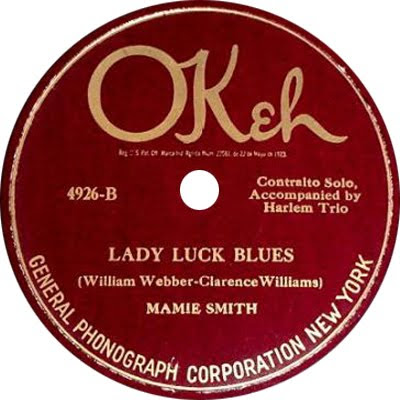
It looks on paper like the collision of two primal forces: Bechet looking to make his name and Mamie Smith aiming to keep her crown as queen of the blues. It winds up as a workable partnership. Bechet has a less cluttered stage (he's joined by just Clarence Williams on piano and Buddy Christian on banjo), giving him room for a beauty of a solo that opens with a run of long, gorgeous notes. And Smith basks in the glow, draws down her own heat. In the '50s, Bechet recalled this track as being one of his favorite performances.
Released as OKeh 4926-B c/w "Kansas City Man Blues"; on Mamie Smith Vol. 3.
August 8, New York:
Amidst the debuts and revolutions, James P. Johnson quietly kept drafting the basics of jazz piano. By 1923, with tracks like "Scouting Around," he had developed an ebullient style of syncopation, the sound of a happy internal conversation.
Released as OKeh 4937; out of print at the moment.
August 9, New York:
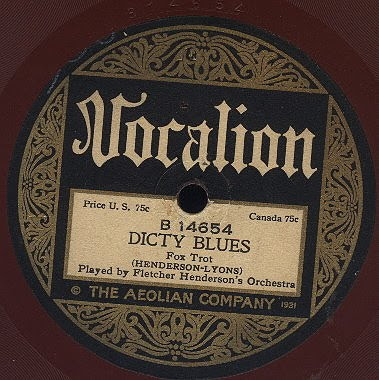
Fletcher Henderson had debuted his new jazz band early in the summer of '23 at New York's Club Alabam, which was in the Nora Bayes Theatre on West 44th St. The Club had been looking for a band to back its new "Negro floor show" and Henderson's group won the audition (Henderson was appointed leader in part because he was a college graduate).
The Henderson Orchestra's debut recording, "The Dicty Blues," was a Henderson original arranged by Don Redman, who plays clarinet. The 18-year old Coleman Hawkins has his inaugural solo on tenor saxophone, one that suggests the makings of a thousand more to come--as Gunther Schuller noted, from the start Hawkins seemed as though he intended to cover the ranges of three saxophones (alto, tenor and baritone) with just a tenor sax. Here, Hawkins pushes the limits of the tenor sax's upper range, as if looking to supplant Redman's clarinet midway through his own song.
With Henderson on piano, Elmer Chambers (tp), Teddy Nixon (tb), Charlie Dixon (banjo) and possibly Billy Fowler (baritone sax). Released as Vocalion B-14654; on A Study in Frustration.
September 21, New York:
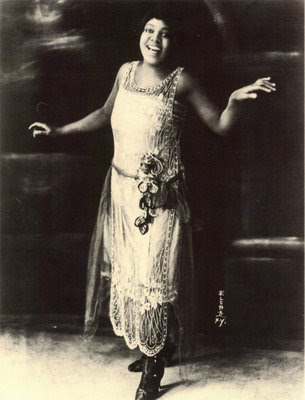
Bessie Smith's "Jail House Blues" starts with what seems like a basic opening line:
Thirty days in jail
with my back turned to the wall
She turns it into blues poetry, centering her force upon a few words, each of which she catches, elongates, drags upward or downward (the repeat of "turned to the wall," for instance, Smith uses to fill out the two bars where normally a trumpet or piano would've come in---she stretches the phrase into a long moan).
So it actually should read:
Thirty DAYS
in JAIL
with my BACK
TURNED
to the
WALL
TURRRRNED
to the
WALLLLL
It's only the first verse. With Irving Johns on piano. Released as Columbia 4001; on Complete Recordings.
September 26, New York:
A week later, Smith returned to the studio to cut "Cemetery Blues" and "Graveyard Dream Blues": death dreams, solitary trips to hell, hot graveyard sex.
Jimmy Jones is the pianist. Released as Columbia 13001; on Complete Recordings.
@ late September or early October, St. Louis:
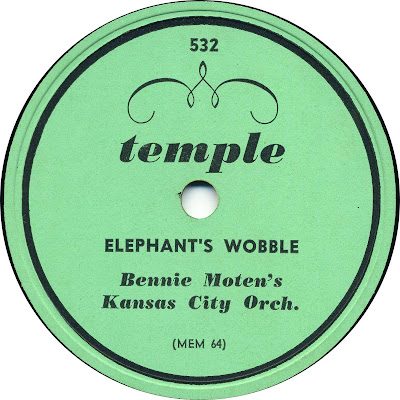
The pianist Bennie Moten may not seem worthy of our pantheon here--his is the most obscure name. But Moten is an underrated bandleader, his group's style emblematic of the emerging Southwestern jazz scene. Much of his band would form the heart of the Count Basie Orchestra in the mid-'30s.
"Elephant's Wobble," one of Moten's first-recorded tracks, is raw and country, chawbacon jazz. There's nothing like the rhythmic sophistication of Oliver's or even Henderson's ensembles here, just a thick, steady stomp and a swaggering three-man horn section playing mainly simple "head" arrangements well (with future Cab Calloway star Lammar Wright on trumpet playing the carnivalesque main theme).
At the same session, Moten's band backed the fine, forgotten blues singer Ada Brown, his band providing a brew of ragtime and blues to match Brown's vocal on "Ill Natured Blues"
With Thamon Hayes (tb), Woody Walder (cl, sax), Sam Tall (banjo), Willie Hall (d). "Elephant's Wobble" (often called "Elephant Wobble", I don't know which is correct) was released as OKeh 8100 (on 1923-1927) and Brown's "Ill Natured Blues" as OKeh 8123 (OKeh Sessions).
October 5, Richmond, Ind.:

"Working Man Blues" partially marks the end of the classic King Oliver lineup. It's one of the last chances for Oliver to outshine his apprentice Armstrong, and as the performance builds to a close, Oliver moves directly up to the microphone and hits, mainly on the second beat, with a flurry of three-note bursts.
In six months' time, Armstrong would leave the group; a few months later, he headed for New York.
Released as Gennett 5275 c/w "Zulu's Ball" (the band also cut a version for OKeh later in October that's almost as good); on The Complete Set.
Top: Marathon dancers, Washington DC, 20 April 1923 (Library of Congress collection).
Sources: Much credit and insight owed to Gunther Schuller's Early Jazz.
Next: The Second Line
Lately in Bowieland: Murder, drugs, dreams, monks, gnomes.
No comments:
Post a Comment